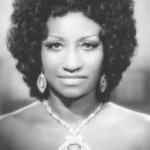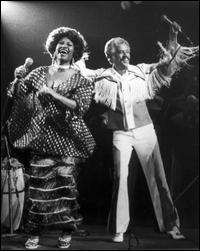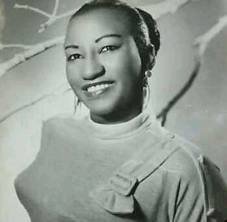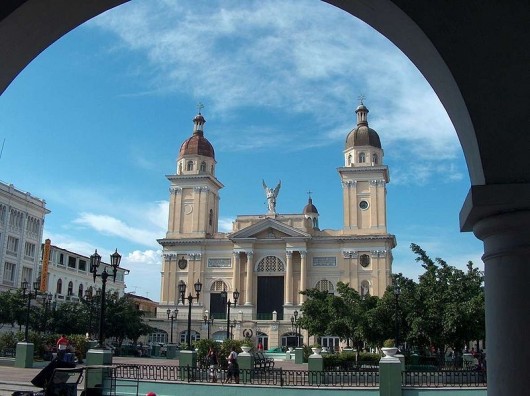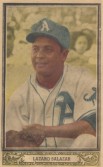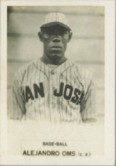Celia Cruz was a Cuban-American salsa singer, and was one of the most successful Salsa performers of the 20th century, having earned twenty-three gold albums. She was renowned internationally as the “Queen of Salsa” as well as “La Guarachera de Cuba.”
While growing up in Cuba’s diverse 1930s musical climate, Cruz listened to many musicians that later influenced her adult career, such as Paulina Alvarez, Fernando Collazo, Abelardo Barroso,Pablo Quevedo, Arsenio Rodríguez, and Arcaño y sus Maravillas.
In 1950, Cruz made her first major breakthrough, after the lead singer of the Sonora Matancera, a renowned Cuban orchestra, left the group and Cruz was called to fill in. Cruz was hired permanently by the orchestra, but she wasn’t well accepted by the public at first. However, the orchestra stood by their decision,and soon Cruz became famous throughout Cuba. During the 15 years she was a member, the band traveled all over Latin America,becoming known as “Café Con Leche” (coffee with milk). Cruz became known for her trademark shout “¡Azúcar!” (“Sugar!” in Spanish). The catch phrase started as the punch line for a joke Cruz used to tell frequently at her concerts. Once, she ordered cafe cubano (Cuban coffee) in a restaurant in Miami. The waiter asked her if she’d like sugar, and she replied that, since he was Cuban, he should know that you can’t drink Cuban coffee without it! After having told the joke so many times, Cruz eventually dropped the joke and greeted her audience at the start of her appearances with the punch line alone.
In her later years, she would use the punch line a few times, to later say: “No les digo más ‘Azúcar’, pa’ que no les dé diabetes!” which means “I won’t say ‘Sugar’ anymore so that you won’t get diabetes”.
With Fidel Castro assuming control of Cuba in 1959, Cruz and her husband, Pedro Knight, refused to return to their homeland and became citizens of the United States.
In 1966, Cruz and Tito Puente began an association that would lead to eight albums for Tico Records. The albums were not as successful as expected. However, Puente and Cruz later joined the Vaya Records label. There, she joined accomplished pianist Larry Harlow and was soon headlining a concert at New York’s Carnegie Hall.
Cruz’s 1974 album with Johnny Pacheco, Celia y Johnny, was very successful, and Cruz soon found herself in a group named the Fania All-Stars, which was an ensemble of salsa musicians from every orchestra signed by the Fania label (owner of Vaya Records). With the Fania All-Stars, Cruz had the opportunity of visiting England, France, Zaire (Today’s DR Congo), and to return to tour Latin America; her performance in Zaire is included in the film Soul Power.
During the 1980s, Cruz made many tours in Latin America and Europe, doing multiple concerts and television shows wherever she went, and singing both with younger stars and stars of her own era. She began a crossover of sorts, when she participated in the 1988 Hollywood production of Salsa, alongside Robby Draco Rosa.
In 1990, Cruz won a Grammy Award for Best Tropical Latin Performance – Ray Barretto & – Ritmo en el Corazon. She later recorded an anniversary album with la Sonora Matancera. In 1992, she starred with Armand Assante and Antonio Banderas in the film The Mambo Kings.
In 1994, President Bill Clinton awarded Cruz the National Medal of Arts.
In 2001, she recorded a new album, on which Johnny Pacheco was one of the producers.
On July 16, 2002, Cruz performed to a full house at the free outdoor performing arts festival Central Park SummerStage in New York City. During the performance she sang, “Bemba Colora.” A live recording of this song was subsequently made available in 2005 on a commemorative CD honoring the festival’s then 20 year history entitled, “Central Park SummerStage: Live from the Heart of the City.”
On July 16, 2003, Cruz died of a cancerous brain tumor at her home in Fort Lee, New Jersey. She was survived by her husband Pedro Knight, who died February 3, 2007.
After her death in New Jersey, her body was taken to Miami to lie in state in downtown Miami’s Freedom Tower, where more than 200,000 of her South Florida fans paid their final respects. Her body was returned to New Jersey where tens of thousands of fans paid tribute to her at the funeral home. A service was held for her in St. Patrick’s Cathedral on Fifth Avenue. She was interred in a private mausoleum at the Woodlawn Cemetery in the Bronx; an epilogue in her autobiography notes that, in accordance with her wishes, Cuban soil that she had saved from a visit to Guantánamo Bay was used in her entombment.
In February 2004, Cruz’s latest album, Regalo del Alma, won a posthumous award at the Premios Lo Nuestro for best Salsa release of the year. It was announced in December 2005 that a musical called “Assuca” would open in Tenerife before touring the world. The name comes from Cruz’s well-known catch phrase of “¡Azúcar!”
On June 4, 2004, the heavily-Cuban-American community of Union City, New Jersey heralded its annual Cuban Day Parade by dedicating its new Celia Cruz Park (also known as Celia Cruz Plaza), which features a sidewalk star in her honor, at 31st Street and Bergenline Avenue, with Cruz’s widower, Pedro Knight, present. There are four other similar dedications to Cruz around the world.
On May 18, 2005, the National Museum of American History, administered by the Smithsonian Institution and located in Washington, D.C., opened “¡Azúcar!”, an
exhibit celebrating the life and music of Celia Cruz. The exhibit highlights important moments in Cruz’s life and career through photographs, personal
documents, costumes, videos, and music.
On September 26, 2007, through May 25, 2008, Celia, a musical based on the life of Celia Cruz, played at the off-Broadway venue, New World Stages. Some
performances were in Spanish and some in English. The show won four 2008 HOLA awards from the Hispanic Organization of Latin Actors.
Source: Wiki/CubanPages/InternetPhotos/YouTube/TheCubaHistory.com
The Cuban Queen: Celia Cruz/ The Cuban History/ Arnoldo Varona, Editor
LA REINA DE CUBA: CELIA CRUZ
Celia Cruz fue una cantante de salsa cubano-americana y fue uno de los intérpretes de salsa más exitosos del siglo 20, que tuvo ganado veintitrés álbumes de oro. Ella fue reconocida internacionalmente como la “Reina de la Salsa”, así como “La Guarachera de Cuba”.
Mientras crecía en los 1930s dentro del clima musical cunbano, Celia Cruz escuchó a muchos músicos que más tarde influyeron en su carrera de adultos, como Paulina Alvarez, Fernando Collazo, Abelardo Barroso, Pablo Quevedo, Arsenio Rodríguez y Arcaño y Sus Maravillas.
En 1950, Celia Cruz hizo su primer gran éxito, después de que el vocalista de la ‘Sonora Matancera’, una orquesta cubana de renombre, dejo al grupo y Cruz fue llamada para llenar su lugar Celia fue contratada de forma permanente por la orquesta, pero no fue bien aceptado por el público en un primer momento. Sin embargo, la orquesta se mantuvieron en su decisión, y pronto Cruz se hizo famosa en toda Cuba. Durante los 15 años ella fue un miembro de la orguesta, la banda viajó por toda América Latina, llegando a ser conocido como “café con leche” (café con leche). Celia Cruz se convirtió en conocida por su marca comercial grito “¡Azúcar!” (“Azúcar” en español). La frase que comenzó como el remate de una broma Cruz solía decir con frecuencia en sus conciertos. Una vez, ordenó Cafe Cubano (café cubano) en un restaurante en Miami. El camarero le preguntó si le gustaría azúcar, y ella respondió que, desde que era cubano, debe saber que no se puede beber café cubano sin él! Después de haber dicho a la broma tantas veces, Cruz finalmente abandonó la broma y saludó a su público en el inicio de sus apariciones con la línea de golpe solo.
En sus últimos años, iba a utilizar su llamado !Azucar! para decir después: “‘Azúcar’ No Mas les Digo, Que pa ‘la diabetes no se les dé!” lo que significa que “no voy a decir ‘Sugar’ más, así para que no tengan diabetes”.
Con Fidel Castro asumió el control de Cuba en 1959, Cruz y su esposo, Pedro Knight, se negó a regresar a su patria y se convirtieron en ciudadanos de los Estados Unidos.
En 1966, Cruz y Tito Puente iniciaron una asociación que daría lugar a ocho álbumes para el sello Tico. Los álbumes no tuvieron tanto éxito como se esperaba. Sin embargo, Puente y Cruz después se unió al sello Vaya Records. Allí, se unió consumado pianista Larry Harlow y se pronto como cabeza de cartel de un concierto en el Carnegie Hall de Nueva York.
En 1974 Celia Cruz grabo un álbum con Johnny Pacheco, ‘Celia y Johnny’, que fue todo un éxito, y Cruz pronto se encontró en un grupo llamado la Fania All-Stars, que era un conjunto de músicos de salsa de todas las orquestas firmado por el sello Fania (propietario de Vaya Records). Con el Fania All-Stars, Cruz tuvo la oportunidad de visitar Inglaterra, Francia, Zaire (hoy República Democrática del Congo), y volver a gira por América Latina, su el rendimiento en el Zaire está incluido en el Soul Power película.
Durante la década de 1980, Cruz hizo numerosas giras en América Latina y Europa, haciendo múltiples conciertos y programas de televisión donde quiera que iba, y
cantando tanto con estrellas más jóvenes y las estrellas de su propia época. Ella comenzó un cruce de clases, cuando participó en el 1988 de Hollywood la producción de la salsa, junto con Robby Draco Rosa.
En 1990, Cruz ganó un premio Grammy a la Mejor Interpretación Latina Tropical – Ray Barretto & – Ritmo en el Corazón. Más tarde se registró un álbum de aniversario con la Sonora Matancera. En 1992, protagonizó junto a Armand Assante y Antonio Banderas en la película The Mambo Kings.
En 1994, el presidente Bill Clinton le otorgó a Celia Cruz la Medalla Nacional de las Artes.
En 2001, grabó un nuevo álbum, en el cual Johnny Pacheco fue uno de los productores.
El 16 de julio de 2002, Cruz actuó a sala llena gratis, al aire libre del festival de artes escénicas Summer Stage del Central Park en Nueva York. Durante la actuación cantó “Bemba Colora”. Una grabación en vivo de esta canción se hizo posteriormente disponible en 2005 en un CD conmemorativo en honor a la fiesta es entonces 20 años de historia, titulado “Central Park SummerStage: En vivo desde el corazón de la ciudad.”
El 16 de julio de 2003, Cruz murió de un tumor cerebral canceroso en su casa en Fort Lee, Nueva Jersey. Pedro Knight, su esposo, sobrevivio a su muerte pero murió 03 de febrero 2007.
Después de su muerte en Nueva Jersey, su cuerpo fue llevado a Miami para estar en el estado en Torre de la Libertad del downtown de Miami, donde más de 200.000 aficionados del Sur de la Florida le rindieron sus respetos finales. Su cuerpo fue devuelto a Nueva Jersey, donde decenas de miles de aficionados rindieron homenaje a ella en la funeraria. Un servicio se llevó a cabo por ella en la catedral de San Patricio en la Quinta Avenida. Ella fue enterrado en un mausoleo privado en el El cementerio de Woodlawn en el Bronx, un epílogo en las notas de su autobiografía que, de acuerdo con sus deseos, el suelo cubano, que había salvado de una visita de la Bahía de Guantánamo fue utilizado en su sepultura.
En febrero de 2004, el último álbum de Cruz, Regalo del Alma, ganó un premio póstumo a Premios Lo Nuestro a la mejor versión de Salsa del Año. Era
anunció en diciembre de 2005 que un musical llamado “Assuca” abriría sus puertas en Tenerife antes de recorrer el mundo. El nombre proviene de la conocida frase de Celia Cruz “¡Azúcar!”
El 4 de junio de 2004, en gran medida a la comunidad cubano-americana-de Union City, Nueva Jersey, anunció su desfile anual del Día de Cuba, dedicando su nueva
Celia Cruz Park (también conocido como Celia Cruz Plaza), que cuenta con una estrella de la acera en su honor, en la calle 31 y la Avenida Bergenline, con el viudo de Cruz, Pedro Knight, presente. Hay cuatro dedicatorias otros similares a Cruz en todo el mundo.
El 18 de mayo de 2005, el Museo Nacional de Historia Americana, administrado por el Smithsonian Institution y con sede en Washington, DC, abrió “¡Azúcar!”, Una
presentación y celebración de la vida y la música de Celia Cruz. La exposición pone de relieve los momentos importantes en la vida de Cruz y de la carrera a través de fotografías, personales documentos, trajes, videos y música.
Desde el 26 de septiembre de 2007 hasta el 25 de mayo de 2008 fue escenificado un musical basado en la vida de Celia Cruz, se presentó en la sede del off-Broadway, Etapas del Nuevo Mundo. Algunos actuaciones fueron en español y algunos en Inglés. El espectáculo ganó cuatro premios HOLA 2008 de la Organización Hispana de Actores Latinos.
Source: Wiki/CubanPages/InternetPhotos/YouTube/TheCubaHistory.com
The Cuban Queen: Celia Cruz/ The Cuban History/ Arnoldo Varona, Editor



